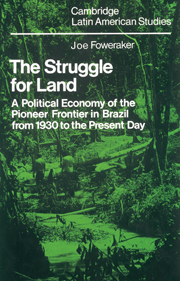 The Struggle for Land
The Struggle for Land Published online by Cambridge University Press: 29 October 2009
In discussing Federal policy for the frontiers, it has emerged that a glaring discrepancy exists between the formal objectives of the State, and the real development which takes place on the frontier. In Chapter 3, it was observed how Federal minimum price and credit policies, which in principle might prevent the transfer of value from the frontier, can, in fact, promote it; in Chapter 5, it was seen how Federal promises to solve the land problems of the frontier were never fulfilled, or not in time to benefit the peasants on the land. This gap between policy making and policy implementation is clearly revealed on the frontiers, which offer a different perspective on the national political process from that available ‘at the centre’. This perspective may correct possible misconceptions of the centre view: at the centre it may certainly be seen what is said, but on the frontier it is seen what is done. The discussion has referred to the difference between the two in terms of the apparent ‘independence’ of the frontier cycle from policy making in the Federal state.
In explaining the gap, there has been reference to the tendency within the authoritarian State to treat political problems as if they were simply administrative, and to the vulnerability of the State administration to the political pressures of economic groups, operating inside and outside the local state land departments.
To save this book to your Kindle, first ensure [email protected] is added to your Approved Personal Document E-mail List under your Personal Document Settings on the Manage Your Content and Devices page of your Amazon account. Then enter the ‘name’ part of your Kindle email address below. Find out more about saving to your Kindle.
Note you can select to save to either the @free.kindle.com or @kindle.com variations. ‘@free.kindle.com’ emails are free but can only be saved to your device when it is connected to wi-fi. ‘@kindle.com’ emails can be delivered even when you are not connected to wi-fi, but note that service fees apply.
Find out more about the Kindle Personal Document Service.
To save content items to your account, please confirm that you agree to abide by our usage policies. If this is the first time you use this feature, you will be asked to authorise Cambridge Core to connect with your account. Find out more about saving content to Dropbox.
To save content items to your account, please confirm that you agree to abide by our usage policies. If this is the first time you use this feature, you will be asked to authorise Cambridge Core to connect with your account. Find out more about saving content to Google Drive.